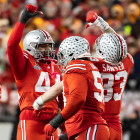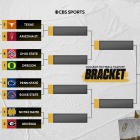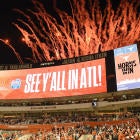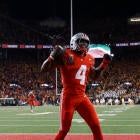Sean Frazier has doubled down on his Group of Five playoff goal.
The Northern Illinois athletic director told CBS Sports the concept he first floated in an ESPN interview may be worth at least $160 million per year to a TV rights-holder.
That would come close to doubling the revenue the 60 Group of Five schools currently get from the College Football Playoff. Frazier says that amount would at least improve the financial stability needed by those so-called mid-major schools playing at the highest level of college football.
"All I'm saying is the directional schools like us, it's just a matter of time," said Frazier, a former Alabama walk-on. "I'm not Nostradamus, but shoot, I'm looking at the trends. ... My donor base is [maxed] out. ... If I don't find new ways to monetize ... one major [solution] is this potential playoff."
"I've been an AD is the Division I, Division II and Division III levels," he later told CBS Sports. "Until somebody comes out and tells me why, emphatically, this is a bad idea, it just tells me we should probably have a conversation."
Frazier says the worth of a Group of Five playoff hasn't been formally priced. That wouldn't happen until an inventory of games was assembled to present to a rights-holder.
However, the $160 million figure came out of discussions with "mentors" and industry analysts, Frazier said. It isn't believed a major network has weighed in.
"We never got any type of quotes because nobody is going to go on record if they don't know the inventory," said Frazier, who played from 1987-1991 for Bill Curry and Gene Stallings at Alabama.
"It would be say it's safe to say it's more than ... the current G5 schools are getting. Who's going to jump on it first?"
The 60 Group of Five schools include members of the Mid-American, Mountain West, American, Sun Belt and Conference USA. They currently receive $90 million annually from the College Football Playoff.
The current regular-season rights deals for those conferences are worth a combined $46 million.
Not included in that CFP total is $6 million for the highest-ranked Group of Five champion that is guaranteed a spot in a New Year's Six bowl. The MAC received that SUM after Western Michigan's appearance in the Cotton Bowl last month. (The CFP's 2016-17 revenue distribution can be found here.)
The top four finishers in the CFP Rankings are in the playoff. A Group of Five school has yet to play for a national championship since the BCS era started in 1998.
The last school to win a national championship from what is now the Group of Five level was BYU in 1984.
In 2012, Northern Illinois became the first and only MAC school to qualify for a BCS bowl. The Huskies lost to Florida State, 31-10, in the 2013 Orange Bowl.
"It's the truth: We don't have an access [point] to the playoff," Frazier said. "The reality is when you say it publicly."
The Power Five conferences (SEC, ACC, Big Ten, Big 12, Pac-12) receive an overwhelming majority of revenue. ESPN is paying $7.2 billion over 12 years for the rights to the CFP. That's an average of $600 million per year.
The Group of Five will make a combined $1 billion from the CFP over the life of that contract.
Still, that contract alone is part of the widening gap between the haves and have-nots of college football. There are strength coaches at Power Five schools making more than Group of Five head coaches.
Two years ago, Texas A&M spent half a billion dollars alone to renovate Kyle Field. That one facilities upgrade is almost 18 times higher than Northern Illinois' entire athletic budget ($28 million), according to the latest figures in USA Today's financial database.
That NIU number ranks 100th overall in Division I -- behind five FCS schools and 42 Group of Five schools and Division I independents.
Frazier received a lot of attention on the Group of Five playoff topic -- not all of it positive -- since first discussing the concept with ESPN in late December.
AAC commissioner Mike Aresco reiterated his stance Sunday when asked about the playoff by CBS Sports.
"Zero interest in the concept," said Aresco, who has added on many occasions his belief the American is the sixth power conference.
"The CFP does provide more to every Group of Five institution," Florida Atlantic AD Patrick Chun said. "The other reality is, I don't know if the Group of Five is that unified to get all five conference involved."
The Group of Five commissioners have a previously scheduled Tuesday conference call. One source said he now expects Frazier's comments to be a subject of that call.
Frazier knows he is an outlier in speaking out on the topic.
"Some guy said I was in the minority of the playoff," Frazier said. "I just hit him back: I've been in the minority for a very long time."
Frazier is one of three African-American ADs in the Group of Five.
Group of Five presidents might see a separate playoff as a tacit creation of a separate -- lower -- division of FBS football. That could negatively affect everything from branding to fundraising to enrollment.
Divided among the 60 Group of Five schools, $160 million averages out to $2.66 million per school. That's not counting NCAA Tournament and bowl payouts. The current average is $1.38 million per school from the CFP.
The SEC just announced a per-school payout of $40 million annually.
It's fair to say the 60 Group of Five schools are happy overall with the current revenue distribution. In the last year of the BCS (2013), the schools split $13 million.
There's no question a Group of Five playoff would make more money. Reality television -- whether "The Bachelor" or sports -- is all the rage. But how much more would make it viable?
One industry analyst told CBS Sports that ESPN currently pays one-third of that $160 million figure for the FCS playoffs, women's Final Four, College World Series and other minor college sports combined.
That source said the litmus test is this: If the Group of Five sold its playoff rights to a channel currently not on your cable system, would you buy that channel?
"I think it would be a challenge," Ohio State AD Gene Smith said. "You have so few television windows."
No size or format of such a playoff has formally been discussed. There would already be TV competition. FBS bowl games begin in mid-December. The CFP begins on or about Dec. 31 and extends into the first or second week of January.
"What I'm saying is, let's monetize the month of December that gives us a chance financially to get us back into the marketplace," Frazier said.
Frazier sees Idaho's situation as an advancing trend. The school is dropping down to FCS in 2018 unable to financially sustain an FBS program in the Sun Belt Conference.
"It's a really contentious thing because, as soon as you start saying that you can't compete, then the next day you say, 'Why are we I doing this?'" Frazier said.
"My response would be, 'Why aren't we sitting down talking about how to fix this before it becomes a situation where we're dropping programs or dropping to FCS?'"
Frazier says 33 percent of his budget is balanced on the backs of student fees attached to tuition. While that's not rare at the mid-major level, it may not be sustainable.
"Right now, I'm not making any money. I'm paying money. I'm trying to figure out how to keep up with the Ohio States, the Michigans, and the Wisconsins, which is a pipe dream," he said.
"I'm going to say I want my brand of football, my brand of competition. How do I do that? Do I keep putting it on the backs of state governments, on my donors?
"State resources coming to public institutions are dwindling. They're going to be gone in the next 15-20 years. That's why you have to increase your enrollment."
Winning football definitely increases enrollment to some degree. Boise State saw applications skyrocket after beating Oklahoma in the 2007 Fiesta Bowl. Alabama is the fastest-growing state flagship university in the country. Enrollment has increased 58 percent since 2006.
That's a year before Nick Saban arrived. The unprecedented football excellence tied to enrollment is not a coincidence.
Gene Smith runs the third-richest athletic department in the country at Ohio State. He has literally been a participant in the current state of college athletics.
As a player, he has a national championship ring having played for Ara Parseghian at Notre Dame. As a coach, he won a national championship working for Dan Devine. As an athletic director, he worked at that Group of Five level at Eastern Michigan. As an administrator, he has been a member of the NCAA infractions committee, Division I Men's Basketball committee and -- beginning this year -- the CFP Selection Committee.
Frazier has a fan in Ohio State's AD, even though Smith's athletic department budget is six times larger than that of Frazier.
"Creative thinking like that is [fine]," Smith said. "He's looking for alternatives, first and foremost, for his teams. Then he's looking for revenue platforms. The thinking, I think, is awesome.
"If we don't throw out things and suggestions that might be out of the box, we're going to stay stagnant."
Just for fun, here's how a Group of Five playoff would have looked in 2016.
| No. 1 Western Michigan vs. No. 8 Western Kentucky | No. 3 Navy vs. No. 6 Houston | ||
| No. 4 South Florida vs. No. 5 San Diego State | No. 2 Temple vs. No. 7 Boise State |
















